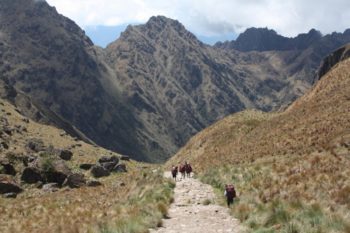What’s the best way to see the world? An endless stream of trekking adventures!

Photo credit: Lisa Weichel
One of the most memorable ways to enjoy a trip is to spend time with nature. From a short hike on a groomed trail to multi-day trekking over uneven terrain, the thrill of observing nature’s unspoiled beauty and the exhilaration of physical challenges can bring unparalleled joy.
For ex-pats, trekking is a great way to make the most of a new home. For short-term travelers, the great outdoors is a welcomed break from crowds and sightseeing buses. Whether you’re meandering along dusty paths to visit the temples of Bagan or preparing for the trip of a lifetime on a pilgrimage to Camino de Santiago, these tips will help you trek safely.
Smart Shoes for your Trek!
Choose your shoes with care. A specialty sporting store can help point you in the right direction. The kind of footwear you’ll need for a week-long expedition is much different than what you’ll need for a weekend of portaging. No matter the selection, take the time to break them in before you go. There’s no misery quite like a blister.
Strain to Avoid Sprains while Hiking
Sprained ankles are a leading cause of visits to emergency rooms. They also account for nearly 50% of all sports-related injuries. If you are prone to sprains, speak with a physiotherapist about an exercise routine. Consider adding a tensor bandage to your first aid kit and make sure your travel insurance is up to date for assistance with sprains or any other trekking-related maladies.
Choose Trekking Gear With Care
All treks and hikes require great footwear, suitable clothing, a generous selection of fluids, energizing snacks, and a rain poncho. But an afternoon hike in a national park rarely requires you to be laden with the latest gadgets. If anything, the abundance of unnecessary gear will slow you down. On the other hand, an off-the-grid trek will require more preparation than simply throwing a pocket knife into a rucksack. Speak with the experts at your local supply store, connect with outdoor communities on social media, and do trial runs with your pack.
Warm-Up and Build-Up
Get ready for your excursion. A short nature walk requires a few minutes of gentle warm-up stretches. A multi-day trek in the Grand Canyon might require months of training and preparation.
Even a hike that’s classified as suitable for beginners can have its challenges, especially if you run into poor weather or have a minor stumble. Know when to turn back and live to trek another day. Study the shortcuts. Many longer treks have side road that loop back to the main road but you’ll only know about it if you study the map.
Where The Wild Things Are
Speaking of studying… brush up on your animal knowledge as well. Knowing what animals share your environment and researching how to identify them can greatly enhance your experience in the wild. And, when you hear a strange creature sniffling outside your tent, it’s good to know if it’s likely a raccoon or a bear.
Don’t Be A Disappearing Act
Share your travel plan. A solo hike can be a wonderful way to connect with nature. And a group outing is a great way for friends to connect with each other. But no matter the size of your party, you should let someone know where you’re going and when you plan to be back. As a result, should the worst happen and you run into trouble, someone will be looking for it. Also, the comfort of knowing there’s someone who will sound the alarm at your absence will help you stay calm under trying circumstances. Trekker Erin Musich says, “Park your car where you can register it with someone. They’ll know when you should be getting back and can alert someone if you aren’t back in time.”
Honoring The Trekking Code
Most of all, take nothing but photographs and leave nothing but footprints. Leaving the trail in better shape than you found ensures that future generations can enjoy the experience as much as you did.
Related:
